The Common Hawk-Cuckoo (Hierococcyx Varius) is one of India’s most iconic yet often misunderstood birds. Widely known by its haunting summer call, “brain-fever, brain-fever!”, this bird is steeped in folklore and fascination. While its resemblance to birds of prey might confuse the untrained eye, a closer look reveals a captivating tale of mimicry, brood parasitism, and seasonal behavior.
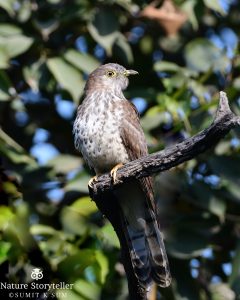
Identification of the Common Hawk-Cuckoo
True to its name, the Common Hawk-Cuckoo resembles a small hawk—specifically the Shikra (Accipiter Badius)—in both appearance and flight. It has a greyish head and upperparts, yellow irises with a penetrating gaze, and finely barred underparts. The long tail is prominently banded with dark and light grey.
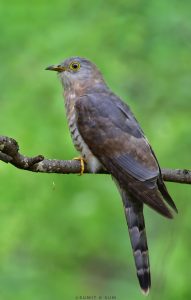
However, unlike raptors, it lacks powerful talons and a hooked beak. It is slimmer, with a more upright posture when perched, often cocking its tail in a very cuckoo-like fashion. If you’re out in the dry deciduous forests of central India or even urban gardens during peak summer, the call is unmistakable—and often the first clue to spotting it.
| Feature | Shikra |
Common Hawk-Cuckoo |
| Eye Color | Yellow | Yellow |
| Underpart Barring | Fine and uniform | Coarse and spaced |
| Tail | Short, narrow bands | Long, broad bands, white tip |
| Beak | Strong, hooked | Slim, curved |
| Call | “Kik-kik-kik” | “Brain-fever!” |
| Hunting | Hunts birds, lizards | Gleans insects, caterpillars |
| Nesting | Builds nest | Lays in Jungle Babbler’s nest |
| Perch Posture | Upright, open | Tail wagging, semi-hidden |
The Brainfever Cry: More Than Just a Call
The name “brainfever bird” is derived from its repetitive, rising three-note call that can echo for hours during the breeding season. Heard most frequently between March and July, this call often becomes the soundtrack of Indian summers—loved by birders, loathed by light sleepers.
The call, often mistaken for distress or illness, is actually a territorial and courtship call. Males are the main vocalists, asserting their presence and seeking mates through their loud cries, often during the hottest part of the day.
Also Read: White-throated Kingfisher – The bird with sharp calls
Common Hawk-Cuckoo’s Breeding Strategy: Masters of Deception
One of the most intriguing behaviors in the avian world is brood parasitism, and the Common Hawk-Cuckoo is a master of this art. Instead of building its own nest or rearing its own chicks, it lays its eggs in the nests of other bird species, primarily the Jungle Babbler (Argya Striata), commonly referred to as the “Seven Sisters.”
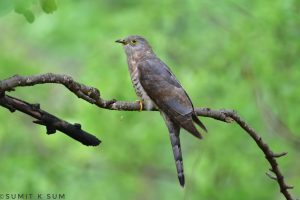
How It Works
The female cuckoo watches host birds closely, waiting for the perfect moment—usually when the host is away from the nest. Then, in a swift and silent move, she deposits her egg among the host’s clutch. In some cases, she may remove one of the original eggs to maintain the clutch size and avoid suspicion.
Why Jungle Babblers?
Jungle Babblers are cooperative breeders, meaning a group helps in raising the young. This creates an ideal environment for the cuckoo chick to receive ample care. Also, the babbler’s clutch is typically large, which makes the addition of a foreign egg less noticeable.
The Fate of the Cuckoo Chick
The cuckoo egg hatches either earlier or simultaneously with the host’s eggs. The chick often outcompetes the babbler chicks in growth and food intake, and in some cases, it may even eject the host chicks from the nest. The unsuspecting babblers continue to feed the intruder, unaware that they are raising a chick that’s not their own.
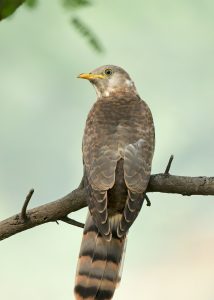
This relationship is a textbook example of evolutionary arms race—as hosts evolve better detection mechanisms, cuckoos, in turn, refine their mimicry and timing.
Behavior and Habitat: Elusive Yet Widespread
Though shy and secretive by nature, the Common Hawk-Cuckoo is surprisingly widespread across the Indian subcontinent. It thrives in dry deciduous forests, scrublands, orchards, and well-wooded urban parks. Its cryptic plumage allows it to blend in among the foliage, and its quiet behavior (apart from the call) helps it avoid attention.
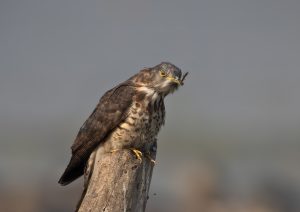
It’s most active during early mornings and late afternoons. Observers may note the bird making short sallies to catch insects, caterpillars, and even lizards—often with a raptor-like flight style that reinforces its mimicry.
Mimicry with a Purpose
Its resemblance to hawks is not merely coincidental. This mimicry likely helps in reducing mobbing from smaller birds. Birds that might otherwise chase off a typical cuckoo think twice before approaching what looks like a predatory hawk. This gives the cuckoo crucial access to host nests.
This form of Batesian mimicry is a brilliant evolutionary tactic, giving it an upper hand in its parasitic endeavors.
Seasonal Migration of Common Hawk-Cuckoos
While many cuckoos are known to migrate long distances between continents, the Common Hawk-Cuckoo exhibits regional or intra-subcontinental migration—shifting its range based on the seasons, food availability, and breeding needs.
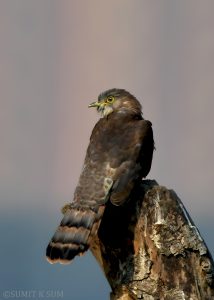
Migration Pattern
- Northern India: The Common Hawk-Cuckoo is largely a summer visitor in the north, arriving in March-April to coincide with the breeding season of host birds like Jungle Babblers. This is when its call dominates the landscape.
- Southern and Central India: In these regions, the bird is largely resident, although it may still exhibit minor seasonal movements depending on rainfall and habitat conditions.
- Post-Breeding Movement: After the breeding season concludes around August-September, many individuals vacate the hotter northern plains and retreat southward or to more forested hill regions.
These migratory patterns help the species optimize its breeding success and resource use throughout the year, showcasing a flexible and dynamic lifestyle.
Suggested Read: Indian Paradise Flycatcher – The Fairy Bird of Forests
The Brainfever Bird in Folklore
The bird’s vernacular names across India reflect a collective fascination with its eerie, rising call. It is called “Papiya” or “Papeeha” in Hindi, “Janglitotari” in Marathi, and “Kondanchitte” in Kannada—names that often imitate or interpret its repetitive cry.
But the most iconic label—“Brainfever Bird”—emerges from colonial times, when British officers believed its loud, repetitive call could drive a person mad. The name caught on in local lore, and to this day, rural communities in north and central India associate the call with heat-induced discomfort or even ominous signs.
In some folk traditions, the bird’s call is believed to summon rain, and its early arrival is taken as a sign of a coming monsoon. In others, it is linked with unrequited love, melancholy, and longing—themes that have found fertile ground in Indian poetry and classical music.
Symbolism of Common Hawk-Cuckoos in Indian Poetry
The call of the Common Hawk-Cuckoo has long been a metaphor in Indian literature—representing yearning, separation, and torment. Much like the Koel in spring, the Hawk-Cuckoo in summer becomes the acoustic symbol of viraha (the pain of separation), especially in classical Hindi and Urdu poetry.
In Braj and Awadhi verse, poets have likened the persistent cry of the “papiha” to the longing of Radha for Krishna, where the call is a reminder of absence and desire.
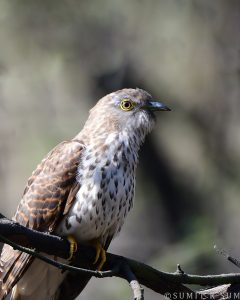
One poetic interpretation goes:
“Papiha pukāre piya-piya, sunat Radha roy”
(The hawk-cuckoo cries ‘beloved, beloved,’ and Radha weeps on hearing it)
In Urdu literature, too, the “papiha” is used to evoke intense emotional states. Poets like Mir Taqi Mir and Ghalib have occasionally referenced the summer cuckoo in the context of loneliness and madness.
Suggested Read: The Magical Indian Peafowl
Influence of Papiha on Music and Raga
In Indian classical music, birds are not merely heard—they are embodied in raagas. The plaintive call of the Common Hawk-Cuckoo is sometimes compared to elements in Raag Malhar and Raag Megh, both associated with the monsoon and the longing for rain.
In folk songs, especially in Bhojpuri and Bundelkhand traditions, the papiha is a recurring character. It is often cast as a messenger bird, much like the swan or koel, bearing tales of love and longing between distant lovers.
A Soundtrack of Solitude
Perhaps more than any other bird except the Koel, the Common Hawk-Cuckoo has the power to shape the emotional landscape of a season. Its unrelenting cry echoes through lonely afternoons, still forests, and empty fields, evoking a timeless mood that lies at the heart of the Indian summer.
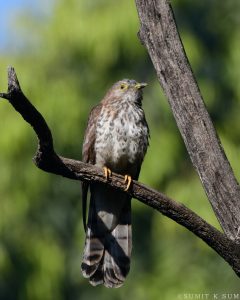
Unlike the visible flamboyance of the Indian Peafowl or the playfulness of babblers, the Hawk-Cuckoo’s mystique lies in absence—you hear it long before you see it. In that sense, it becomes not just a bird, but a symbol—of invisibility, of hidden emotion, of persistence in solitude.
Conservation Status of Common Hawk-Cuckoos
Currently listed as Least Concern by the IUCN, the Common Hawk-Cuckoo benefits from a wide distribution and a stable population. However, habitat degradation and the decline of host species could pose long-term challenges.
For now, though, the call of the “brainfever bird” remains a reliable sign that summer has arrived.
Find More Amazing Birds Here
| Brown-headed Barbet | Indian Pitta |
| Sarus Crane | Common Kingfisher |
| Spotted Owlet | Purple Sunbird |
